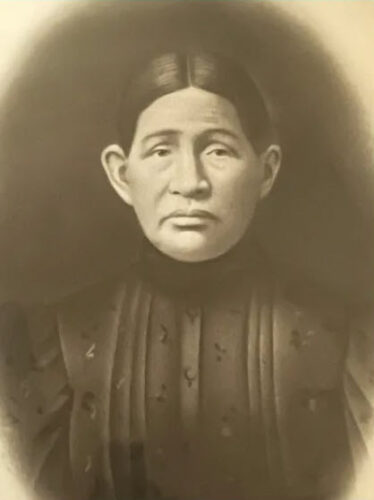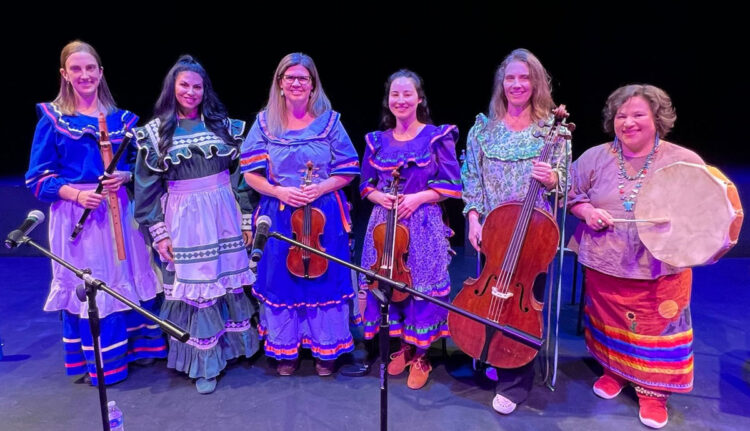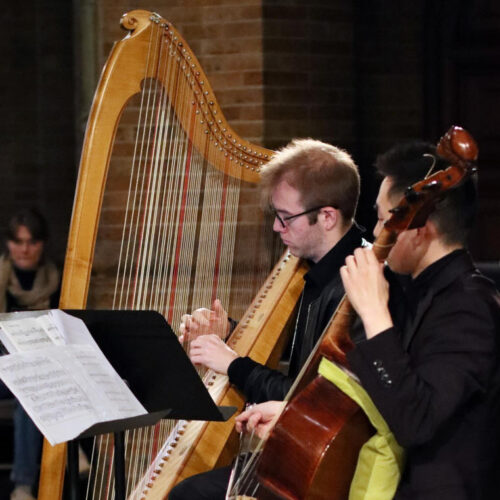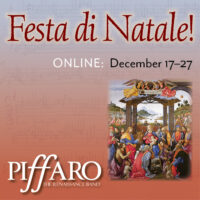by Brandi Berry Benson
Published April 18, 2025
Editor’s note: The author received the 2023 Thomas Zajac Memorial Scholarship, awarded for specialized study in regional or folk traditions, instruments, or styles that help explore cultural connections in early music. EMA membership helps support these and other scholarship programs, and together we can help early music flourish. Join EMA today.
An old portrait, a family legacy, and music from the Chickasaw and Choctaw Nations

It all started with a portrait of my Chickasaw great-great-great-great-grandmother that still hangs in my parents’ living room. Growing up, I heard stories of my ancestors, and every time I would gaze at her I would see a woman of immense strength who carried the Chickasaw reputation of “unconquered and unconquerable.” As I researched more of my lineage through my mother’s side of the family, I became increasingly interested in the music of the Chickasaw and Choctaw Nations.
The Story of Pa I Sha was a culmination of that research. The work highlights four major stories from my family’s lineage, and was premiered in 2023 by my ensemble, the Bach & Beethoven Experience, in partnership with the Gichigamiin Indigenous Nations Museum and other sponsors in Evanston, Ill.
In a few weeks, on May 15, the Bach & Beethoven Experience will again perform The Story of Pa I Sha at Northwestern University’s Regenstein Hall — an event co-sponsored by Northwestern’s Center for Native American and Indigenous Research (CNAIR). The concert is free and open to the public.

The first story is about Pa I Sha herself, born in Horn Lake, Mississippi, in 1813. She walked what history books call the Trail of Tears, the forced removal of the Five Civilized Tribes — the Cherokee, Chickasaw, Choctaw, Muscogee (or Creek), and Seminole — from their homelands to Indian Territory in present-day Oklahoma. It was a treacherous journey on foot across several hundred miles. The Chickasaws called this dark chapter “the Removal.”
Just after the Removal, or perhaps along the way, Pa I Sha met and married her husband. They started to build a new life together, but Pa I Sha’s was cut short giving birth to her daughter, Mary. The second story is about that daughter, Mary, who met a Civil War soldier named John on the banks of the Red River. He was missing in action and needed to return to finish out his service, but they married at the Chickasaw-run boarding school Bloomfield Academy, just after the war ended. Their interracial marriage was considered taboo, and they had to live outside of town in a tent.
Eventually, they were able to establish the town of Yarnaby, in what’s now southern Oklahoma, and had nine children of their own. John was given permission from the Chickasaw Nation to erect his own gristmill and cotton gin. He was considered a friend and marked “intermarried white” on the Dawes Rolls, a U.S. government registry of people deemed to be an “official” member of the Five Civilized Tribes and thus entitled to a parcel of land in exchange for abolishing their tribal governments and accepting federal laws.
The third story is about one of Mary and John’s daughters, Rosa Ella, who also married a white man. When Indian Territory became the state of Oklahoma, fear swept through the family. Rosa concealed her Chickasaw identity as much as she could and denied her full-blood quantum for fear of becoming a ward of the state. From 1920 on, she dropped her Indigenous identity altogether and declared herself and her children “white” in every census. Many of my relatives of that generation also modified their degree of Indigenous blood on their records to avoid the same fate.
The final story is about my great-grandfather, the last of my relative on the Dawes Rolls. Rosa had given birth to my great-grandfather, Earnest, in Indian Territory, but moved with her husband and son to the Texas panhandle after Oklahoma became a state. Meanwhile, a little girl named Elvera was traveling with her family by train from southern Illinois to establish a new life in Texas. Earnest later met and married Elvera, and they had a beautiful home wedding showered with gifts from their communities, a sign they were well loved and popular with the people of the town. Even though Earnest continued to declare himself white on census records, he and Elvera traveled often to Tishomingo, the Chickasaw Nation’s capital, to find out all he could about his Chickasaw lineage.
To help tell these real-life family stories, I weaved into my musical The Story of Pa I Sha narrative a combination of my original settings of Chickasaw traditional songs, social dances, and Choctaw hymns. The Chickasaw and Choctaw tribes were, at one time, a single tribe and were neighbors in their homeland and in Indian Territory. Their language and music are very similar. In fact, the Chickasaws adopted the Choctaw hymnal into their musical canon.
There are several traditional songs and dances that I use as various motifs throughout this work. The first is the Memorial Song, or “La Palata,” which was often sung as a funeral song or Removal song. I use it to represent where Death has taken an ancestor and also to depict the death of a former life as a result of the Removal. The “Stealing Partners” dance is a courting dance in which men could “steal” their partners for marriage. This melody is used when Pa I Sha, Mary, and Earnest meet their future spouses. Another melody I use throughout is the Choctaw Hymn 11, traditionally sung in Sunday school for children in the Chickasaw and Choctaw communities. I use this hymn to represent the various births of family members as the story progresses. The Stomp dance and the Garfish dance are some of the oldest dances in Chickasaw culture, and I match those sounds with our string instruments and include the round drum which is a foundational voice in these dances. (As an intriguing side note, in my research I came upon a photo of a music class of Chickasaw women at the Bloomfield Academy who were holding violins, guitars, and mandolins.)
This upcoming performance will feature narrator and vocalist Rachael Youngman, a citizen of the Choctaw Nation and the producer of the podcast Native ChocTalk. The narration is in English with some Choctaw language, and Rachael sings Choctaw hymns in the Choctaw language as well. My Bach & Beethoven Experience co-director, Leighann Daihl Ragusa, performs on both the Native American flute and the traverso.
In keeping with the Chickasaw tradition of the flute as a greeting, and often accompanied with rattles, I wrote Chickasaw flute motifs throughout The Story of Pa I Sha to represent times of new-ness at different parts of the stories. Michaela Marchi (tribal affiliation Isleta Pueblo) joins on Indigenous percussion with a variety of rattles, hand drum, and striking sticks that are used for specific moments and dances in the work in keeping with what’s traditional for certain dances.
There are a few music selections outside of the Chickasaw and Choctaw Nations that I’ve arranged to help tell my family’s history as well. I use the Union’s “Battle Hymn of the Republic” melody on top with parts of the Confederate song “God Save the South” underneath in the violin and viola parts to depict the two sides of the Civil War. The cello imitates the snare drum, and the round drum reinforces that percussive rhythm underneath. I bring back the “Stealing Partners” dance for when Mary meets John, and include my arrangement of “The Girl I Left Behind Me” for when John promises to return to Mary after the war.
I chose the instrumentation: Chickasaw flute, traverso, and members of the violin family, violin, viola, cello as a nod to the fact that an “orchestra” is mentioned at Bloomfield Academy and violin is one of the instruments held by the group of Chickasaw women in the one photo I’ve been able to find of a music class there. Midwest period string players Kiyoe Matsuura (viola), and Erica Rubis (cello) also join us for this May 15 performance of The Story of Pa I Sha.
I am incredibly grateful for my family and to know our history, and for great-grandfather Earnest who left his findings for me to build and expand upon as I have put this story together.
Brandi Berry Benson serves on the faculty of Northwestern University, where she works with the Baroque Music Ensemble, and DePaul University, where she teaches Baroque Performance Practice and Ornamentation. She is a faculty affiliate with Northwestern University’s Center for Native American and Indigenous Research. brandiberrybenson.com




